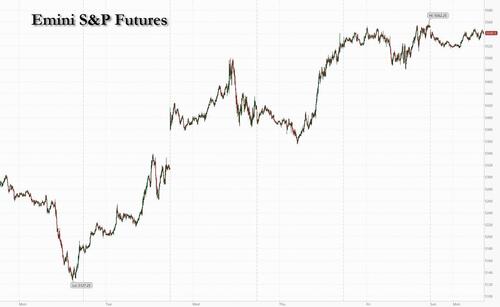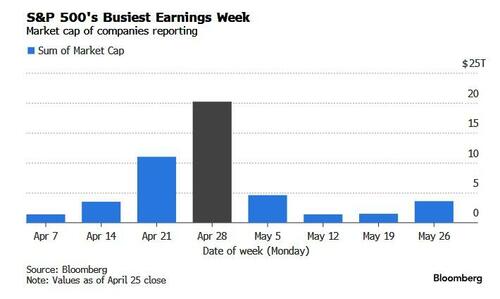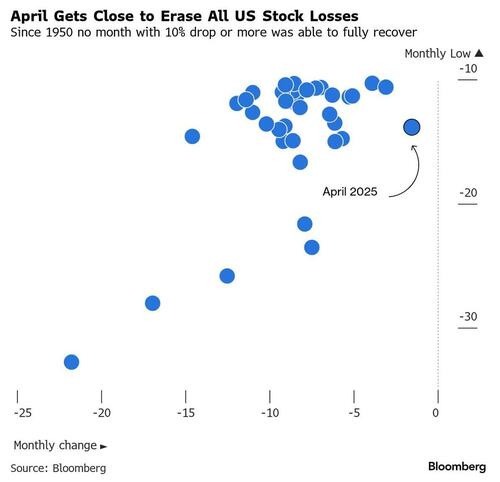


US equity futures are little changed, reversing earlier losses as much as 0.5%, as global markets are broadly in the green amid a burst of positive sentiment, which even pushed JPM's recently bearish trading desk to turn tactically bullish this morning (more in a subsequent post). As of 8:00am ET, S&P and Nasdaq futures are down 0.1%, but well off session lows. Nvidia shares fell 1% in premarket after the Wall Street Journal reported China’s Huawei Technologies is getting ready to test a new and powerful artificial intelligence processor that the company hopes can replace some products made by Nvidia; other Mag7 names are mixed with Cyclicals/Semis under pressure and Defensives catching a bid. Europe's Estoxx advanced 0.5% over early London session with gains led by info tech and consumer staples; Asian stocks were also broadly higher with Japan erasing all post-Liberation day losses. US equities are focused this week on the tech sector, with Microsoft, Apple, Meta and Amazon all reporting earnings. The week also includes the April US jobs report, due Friday. Bond yields are higher as the curve bear steepens and the USD starts the session stronger. This is a data-heavy week but today’s focus is on regional Fed activity but the key’s this week are NFP, JOLTS, ISM-Mfg, and 25Q1 metrics.
In premarket trading, Nvidia shares slip after the WSJ reported that Huawei is getting ready to test an artificial intelligence processor that the Chinese tech giant hopes can replace some Nvidia products; others Mag7 stocks are Alphabet 0.06%, Meta Platforms +1%, Amazon +0.1%, Tesla +0.8%, Nvidia -1.5%, Microsoft -0.2%, Apple 0.6%. Boeing rises 1.5% as Airbus SE agreed to take over some assets and sites from Spirit AeroSystems, clearing the way for Spirit to be acquired by Boeing. Also, Bernstein upgraded Boeing to outperform, noting that the aircraft maker is now “making the progress it needed for the growth trajectory.” Eli Lilly slips 1.6% after HSBC double downgraded the stock to reduce — a sell-equivalent rating — from buy, saying the drugmaker’s risk-reward “is not attractive.” Here are some other notable premarket movers:
US futures posted modest moves as investors awaited reports from American companies worth $20 trillion, including four mega tech names AAPL, AMZN, MSFT and META, and watched for progress in US trade talks with Asian partners. Wild gyrations sparked by Trump’s April 2 tariff announcements have eased somewhat, but investors will be scrutinizing this week’s key company reports for the earnings impact of US trade policies. Fresh readings on the state of the American economy may support hopes of earlier-than-expected Federal Reserve interest-rate cuts.
Four of the Mag 7, Microsoft, Apple, Meta and Amazon, are due to report earnings this week. Analysts expect the group to deliver an average of 15% profit growth in 2025, a forecast that’s barely budged since the start of March despite the flareup in trade tensions. In terms of market capitalization, it’s the busiest week of the year for earnings, with S&P 500-listed companies worth $20 trillion reporting.
Investors are also watching for any signs of progress in US trade negotiations after Trump suggested another delay to his higher tariffs was unlikely. Asian economies, facing some of the highest US “reciprocal” tariffs, are leading the way over their western counterparts in talks with the administration.
“Ultimately, it seems that we’re moving towards a place where these policies start to make a little more sense,” Themistoklis Fiotakis, global head of FX strategy at Barclays Plc, told Bloomberg TV. “If this starts shaping up in a place where markets can understand it, can quantify it, then I think that things are going to normalize.”
To help manage the next steps, the Trump team has drafted a framework to handle negotiations with about 18 countries, including a template that lays out common areas of concern to guide the discussions. US Treasury Secretary Scott Bessent said the administration is working on bilateral trade deals with 17 key partners, not including China. Bessent reiterated the administration’s argument that Beijing will be forced to the negotiating table because China can’t sustain Trump’s latest tariff level of 145% on Chinese goods. Its standoff with China will likewise limit the potential benefits the US can reap from deals with Asian trading partners, according to Phoenix Kalen, global head of emerging markets research at Societe Generale SA.
“Already there has been a lot of investor sentiment and positioning for some deals to be done, especially with Japan, especially with South Korea,” Kalen told Bloomberg TV. “But the scope is going to be relatively limited and hampered. The concern especially for Asian trade partners around how China will respond to the terms will limit the extent to which they can agree to certain terms with the Trump administration.”
Meanwhile, Friday’s US non-farm payrolls figures will also turn attention to the health of the American economy. “In general I think this week’s data won’t be too bad for the economy because it really precedes the announcement of tariffs,” Kathy Jones, chief fixed income strategist at Charles Schwab & Co., told Bloomberg TV. “The inflation numbers shouldn’t be too bad. But I’ll really be watching the ISM numbers at the end of the week and of course, the jobs data where we could see some softness.”
The S&P 500’s recovery month-to-date from a 14% drop to -1.5% as of Friday’s close is one of the best rebounds since 1950. Still, the bounce has been too narrow to instill much confidence in a sustainable longer-term rally. Traders may stay cautious as gains have been largely headline and short-covering driven. Volatility is abating but remains elevated. It’s also coming up to the 100-day mark for Trump’s presidency.
In Europe, the Stoxx 600 is set to extend its winning streak to a fifth session as it climbs 0.7%, boosted by M&A news out of Italy as Mediobanca made a €6.3 billion ($7.1 billion) offer for the wealth management arm of Italian insurer Assicurazioni Generali SpA. Food & beverage, travel & leisure and bank stocks are leading gains while real estate and industrials lag. Here are some of the biggest movers on Monday:
Earlier in the session, Asian shares also rose as focus shifted to a slew of major earnings from the region, while signs that trade tensions may have peaked, at least for now, helped sentiment. The MSCI Asia Pacific Index rose as much as 0.8%, adding to last week’s 2.2% gain. Japanese benchmarks outperformed following a report on Toyota Motor Corp. chairman’s proposal to buy out Toyota Industries. Indian shares resumed their climb amid foreign inflows, while Chinese stocks were range-bound as officials reiterated their plan to strengthen support for employment and the economy. The flood of tariff-related headlines has slowed somewhat, and investors are turning their attention to earnings to gauge how Asian firms are prepared to tackle higher levies. The region is facing its busiest earnings week this season, with China’s biggest banks including Industrial & Commercial Bank of China Ltd. and Bank of China Ltd. set to release results.
“Broadly, we’re seeing some relief positioning as there is some refocusing on fundamentals, which I would say is tariff fatigue,” said Billy Leung, senior investment strategist at Global X ETFs in Australia. On China’s earnings, markets want to see more commentary from corporates on domestic confidence, he added.
In rates, treasuries were cheaper across the curve, with futures extending a drop into the early US session as investors digest news around US trade talks with Asian partners. US yields were cheaper by 2bp to 5bp across the curve, with intermediates underperforming slightly, flattening 5s30s spread by 2bp on the day. US 10-year yields traded around 4.27%, down 4 bps from Friday's close; European bonds also decline with bunds lagging by 1bp and gilts outperforming 1bp. Next Treasury coupon auction is scheduled for May 5.
In FX, the Bloomberg Dollar Spot Index is flat; New Zealand dollar lags G-10 peers and the pound leads gains, rising 0.3% against the greenback.
In commodities, spot gold falls $42 to around $3,278/oz. Oil prices are steady with WTI just below $63 a barrel.
In crypto, bitcoin rose 1.1% to $95,344.86; ether rose 0.9% to $1,819.53.
Looking at the US economic calendar, it's quiet - we only have the April Dallas Fed manufacturing activity at 10:30am. Fed officials are quiet due to blackout period. This week also includes JOLTS, consumer confidence, PCE, GDP, ISM manufacturing and April payrolls. Fed’s external communications blackout ahead of the May FOMC meeting started Saturday.
Market Snapshot
Top Overnight News
Tariffs/Trade
A more detailed look at global markets courtesy of Newsquawk
APAC stocks were mixed amid a lack of major catalysts from over the weekend and with a very quiet calendar to start a busy week of earnings results and key data releases including the latest US NFP report. ASX 200 was led higher by outperformance in tech, healthcare and energy, while miners lagged after mixed production updates. Nikkei 225 advanced at the open as participants digested earnings releases and M&A news in which Toyota Motor's chairman and founding family made a takeover proposal for Toyota Industries. However, the index has since pulled back from today's peak after failing to sustain a brief return above the 36,000 level. Hang Seng and Shanghai Comp lagged amid some disappointment from Beijing's press conference on policies and measures for stabilising employment, ensuring stable growth and promoting high-quality development which was conducted by the deputy heads of government agencies and the PBoC and lacked any major concrete policy measures. Japan's TOPIX Index erases all losses since the April 2nd US tariff announcement.
Top Asian News
European bourses (STOXX 600 +0.4%) opened modestly firmer across the board, and have traded rangebound throughout the morning thus far given limited fresh macro drivers. European sectors hold a strong positive bias, but with the breadth of the market fairly narrow. Food Beverage & Tobacco takes the top spot, joined closely by Autos. Real Estate sits at the foot of the pile, given the relatively higher yield environment today.
Top European News
FX
Fixed Income
Commodities
Geopolitics: Middle East
Geopolitics: Ukraine
Geopolitics: Other
US Event Calendar
DB's Jim Reid concludes the overnight wrap
It was a joyous but painful weekend as Liverpool won the Premier League for only the second time in my adult life but I broke a toe cooking the kids’ dinner! Given you’re no doubt wondering how, I basically caught my right little toe on the kitchen island as I was walking round it. It was extremely painful and ballooned up to nearly the size of a golf ball.
While trying to take my mind off the pain, this week will be the first for a while where data and earnings will compete with tariff headlines as it’s a bumper week on this front. In terms of data the main highlights in the US are payrolls (Friday), core PCE inflation and US GDP (Wednesday), ISM manufacturing (Thursday) and the latest JOLTS and consumer confidence tomorrow. In Europe flash CPI numbers get released from Spain tomorrow, Germany, France and Italy on Wednesday, with the Eurozone aggregate on Friday (our economists’ preview is here). On Wednesday, Q1 GDP reports are due for Germany, France, Italy and the Eurozone. In Asia, the focus will be on the BoJ meeting (Thursday - our preview here) and April PMIs in China (Wednesday).
An avalanche of corporate earnings will centre around results from Microsoft and Meta on Wednesday and Apple and Amazon on Thursday. This will contribute to a whopping 40% of S&P 500 market cap reporting this week. It's fair to say that these Mag-7 earnings will go a long way to dictating the tone of the week. As I mentioned last week remember that before Liberation Day the main theme bubbling in the background was the Mag-7 underperforming due to DeepSeek, worries about extreme levels of Capex needed to power AI forward, valuations and a disappointing Q4 reporting season around the end of January. Three months on we'll see what earnings look like.
Elsewhere we see the federal election in Canada today. Remember the ruling Liberal Party were frequently 25pp behind in the polls in early-mid January even after Trudeau had announced his resignation as leader. However after the "51st state" rhetoric and aggressive tariffs, the rally round the flag movement has propelled the Liberals into a 3-4pp lead in current poll of polls which if replicated today would likely give them a small majority. So a remarkable turnaround. Elsewhere in politics, Wednesday will mark President Trump’s first 100 days in office. So expect lots of reflections on this landmark. The UK holds local elections on Thursday with the main point of interest being how well the populist Reform Party does given they have recently edged ahead of the ruling Labour Party in national polls.
So its fair to say its a busy week. Let's go into more detail on some of the main data points. Firstly, in terms of payrolls, our economists forecast that headline (+125k forecast vs. +228k previously) and private (+125k vs. +209k) payrolls will mean revert after a strong March, particularly within the leisure/hospitality and retail sectors. Our econ team point out that March and April can get whipped around due to the timing of Easter and school spring breaks. Unemployment should remain steady at 4.2% though.
Wednesday's advance Q1 GDP will be interesting as the consensus suggests only +0.4% annualised growth in the quarter (+1.1% expected at DB vs. +2.4% in Q4) so that will raise some concerns if it materialises. At the same time we see March personal income (+0.5% DB vs. +0.4% last month) and spending (+0.6% DB vs. +0.4%) data. This will also contain the latest reading on the core PCE deflator (+0.1% vs. +0.4%) which is expected to be on the softer side this month. This will be welcome but remember this is all largely pre-tariffs.
The day by day week ahead is at the end as usual, including the highlights from a busy week for earnings on both sides of the Atlantic. One final thing to note is the US Treasury’s updated borrowing estimates (today) and the subsequent refunding announcement (Wednesday). This normally gets released without too much fuss but remember that in Summer 2023 (end July/early August) this quarterly announcement helped cause brief but great stress in markets due to higher than expected borrowing and more long-dated issuance. Since then the Treasury has managed the process with a view to minimising market fears but in an era of large borrowings these events are always worth keeping an eye out for. Our strategists’ preview and forecasts are here.
Asian equity markets are mixed this morning with local markets mostly higher but US futures notably lower. As I check my screens, the S&P/ASX 200 (+0.81%), the Nikkei (+0.51%) are comfortably higher with the KOSPI (+0.15%) seeing more minor gains. Chinese equities are mostly trading around the flatline but S&P 500 (-0.52%) and NASDAQ 100 (-0.60%) futures are lower.
Recapping last week now and markets put in a strong performance thanks to several factors. First, Trump signalled that he wanted to make a deal with China, and he said that tariffs on China could fall “substantially” from the 145% level at present. Second, Trump rowed back on his previous criticisms of Fed Chair Powell, saying that he had “no intention” of firing him, which reassured investors concerned about central bank independence. And third, there were increasing signs that the US economy was still holding up relatively well in the circumstances, as data like the weekly jobless claims and the April flash PMIs weren’t signalling a recession.
Against that backdrop, the S&P 500 recovered +4.59% over the week (+0.74% Friday) to close at its highest level since Liberation Day. In fact, the latest moves now leave the index just -2.57% beneath its level on April 2. That move was supported by a very strong performance for the Magnificent 7, which surged +9.17% (+2.86% Friday). And that strength wasn’t just confined to the US, as last week also saw gains for the STOXX 600 (+2.77%), the Nikkei (+2.81%) and the MSCI EM index (+2.67%).
That easing in market stress was evident from several other indicators last week. For instance, US HY credit spreads tightened for a third consecutive week, falling -38bps (-8bps Friday) to 360bps. US real yields also fell back, with the 10yr real yield down -12.3bps (-4.8bps Friday) to 1.97%, closing beneath 2% for the first time in over two weeks. In addition, the VIX index of volatility was down for a third consecutive week, ultimately falling -4.81pts (-1.98pts Friday) to 26.33pts, marking its lowest closing level since Liberation Day.
With the more positive headlines on tariffs and the economy, US assets more broadly began to stabilise, including the US Dollar itself. That saw the dollar index finally post a modest weekly gain after 4 consecutive declines, up +0.24% (+0.09% Friday). Similarly, US Treasury yields moved lower, particularly at the long-end of the curve, and the 10yr yield fell -8.9bps over the week (-8.0bps Friday) to 4.24%, marking its second consecutive weekly decline.



